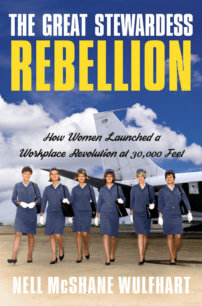In the mid-20th century, air travel was considered glamorous, even romantic. Federal regulation kept fares high, and passengers were mostly businessmen en route to work destinations. And what did those men want to see at the end of a long work week? A blushing, girlish attendant who doted on them—or so the airlines assumed. A new pair of nonfiction books offer insight into the sexism women faced in the early decades of commercial flight, as seen through the eyes of the women who lived it.

The Great Stewardess Rebellion recounts the midcentury fight to get airlines to overturn their sexist requirements for flight attendants. In the 1960s, stewardesses were often fired after their 32nd birthdays, or upon marriage, or upon becoming pregnant—whichever came first. Their continued employment was dependent on regular weigh-ins, and they were required to meet other physical expectations, too, such as cutting their hair to their employer’s standard or wearing gloves while in uniform.
Journalist Nell McShane Wulfhart traces flight attendants’ union and legal battles throughout the 1960s and ’70s, focusing on two women whose experiences help make the political personal. Patt Gibbs was unconcerned with age limits when she applied to American Airlines at age 19, since 32 seemed impossibly distant, and she happily monitored her weight to better her chances of being accepted, dropping from 121 to 110 pounds before submitting her application. However, once Gibbs was hired and she saw how poorly she and her colleagues were treated, she became involved in union work—reluctantly at first, then as a passionate advocate for better pay and fewer discriminatory rules.
Like Gibbs, Tommie Hutto also became enraptured by air travel as a young woman. She became an American Airlines flight attendant after college graduation, as a way out of her conservative Texas surroundings. Hutto, too, became involved in the union, and as she and Gibbs sought better treatment for the women who staffed every flight, they transformed from adversaries to allies.
Wulfhart tells the story of airline unions through Gibbs’ and Hutto’s experiences while weaving in the tales of dozens of other bold women—such as Sonia Pressman, who fought for airline industry change as an attorney for the Equal Employment Opportunity Commission; Dusty Roads and Jean Montague, American Airlines flight attendants who brought the industry’s discrimination to the EEOC’s attention; and Cheryl Stewart and Sharon Dunn, Black flight attendants who challenged their colleagues’ racism. With stylish flair, The Great Stewardess Rebellion explores the nuances of these spirited women and the sexism they battled.

While Wulfhart reveals how women fought to change air travel, Ann Hood paints a portrait of how air travel shaped one woman’s life. Hood (The Book That Matters Most, The Red Thread) is now a bestselling novelist, but in the late 1970s and early ’80s, she was a TWA flight attendant. She always wanted to write, but first she wanted to see the world beyond her Rhode Island home, especially after falling in love with air travel when she took her first flight to Bermuda as a teen.
Hood’s memoir, Fly Girl, brims with details and personal anecdotes that air travel buffs will love. She recounts both the horrifying ways that misogyny affected her workplace, including unwanted advances from badly behaved passengers, and happier memories of the glamorous days of flying, when stewardesses could bring home sizable paychecks thanks to the work of the flight attendants’ unions. However, as the industry changed in the 1980s, Hood experienced furloughs and had to take jobs with less affluent airlines, bouncing from plane to plane. Through all the ups and downs, jet lag was her normal.
With time, Hood’s self-confidence grew, with regard to both her ability as a flight attendant and her understanding of people and cultures. She began to use time in the jump seat to write, and steadily she made her way toward the writer’s life she’d always dreamed of.
“Life unfolds on airplanes,” Hood writes. “People are flying to funerals and weddings, they are on their honeymoon or leaving a partner, they are carrying a newborn on their first flight to meet grandparents or taking a kid to college or on their way to adopt a baby. And they fall in love.” In Fly Girl, Hood paints a first-class portrait of chasing your dreams and coming of age in the sky.
